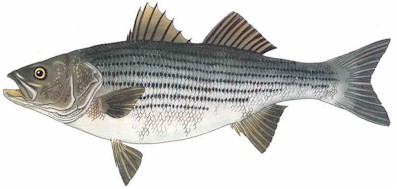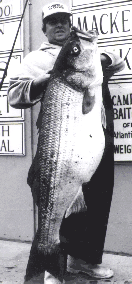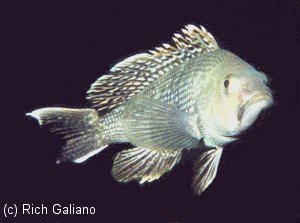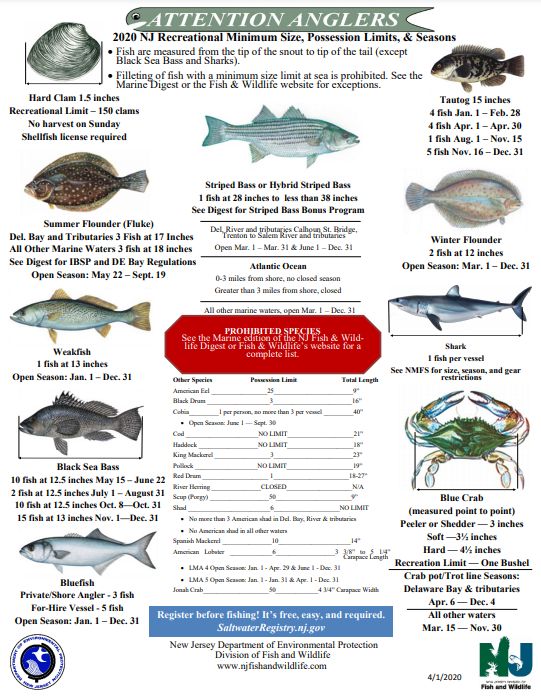Striped Bass

Morone saxatilis
Profile by Thomas Baum,
Senior Fisheries Biologist
Common Name:
Striped Bass, also called Rockfish, Rock, Striper, and Linesider
Range:
Striped bass occur naturally along the Atlantic coast from the St. Lawrence River in Canada to the St. John's river, Florida, and in some river systems along the Gulf of Mexico from western Florida to Lake Pontchartrain, Louisiana. It is a coastal fish, inhabiting near-shore ocean waters as well as adjacent bays, sounds, and tidal rivers. Some naturally reproducing stocks have been established in freshwater rivers, lakes, and reservoirs.
Striped bass were introduced very successfully to the Pacific Coast in the late 1800s. Yearling striped bass were seined from the Navesink and Shrewsbury Rivers near Red Bank, New Jersey in 1879 and again in 1881, and transported by train across the continent to San Francisco Bay. Water in the holding containers had to be replenished along the way and agitated by hand to keep the young fish alive. The transported fish adapted so well, that in 1899 the net catch of striped bass for the Pacific Coast was 1.2 million pounds. Striped bass now cover a major portion of the West Coast from San Diego California to as far north as the Columbia River in Washington
Size:
Females generally grow larger than males and the growth rate slows as the fish get older. Striped bass are relatively long-lived, some fish have been determined to be at least 29 years old. The overall record is a 125-pound fish caught in 1891 by a commercial fisherman in North Carolina. Albert McReynoids caught the World Record Striped Bass for rod and reel in 1982, from a jetty in Atlantic City, NJ. The fish weighed 78 pounds, 8 ounces and measured 53 inches in length and had a 34-inch girth.
| Length | Age | Weight (lbs) | ||
| yrs | Max | Avg | Min | |
| 12" | 1 | 1.0 | 1.0 | 1.0 |
| 13" | 1 | 2.0 | 1.5 | 1.0 |
| 14" | 2 | 2.5 | 2.3 | 2.0 |
| 15" | 2 | 3.0 | 2.5 | 2.0 |
| 16" | 2 | 3.5 | 3.0 | 2.5 |
| 17" | 3 | 4.0 | 3.5 | 2.8 |
| 18" | 3 | 4.5 | 4.0 | 3.0 |
| 19" | 3 | 5.0 | 4.3 | 3.5 |
| 20" | 3 | 5.5 | 4.8 | 4.0 |
| 21" | 4 | 6.0 | 5.0 | 4.3 |
| 22" | 4 | 6.8 | 5.8 | 4.8 |
| 23" | 4 | 7.5 | 6.3 | 5.0 |
| 24" | 5 | 8.3 | 7.0 | 6.0 |
| 25" | 5 | 8.8 | 7.8 | 6.3 |
| 26" | 6 | 10.0 | 8.5 | 7.0 |
| 27" | 6 | 11.0 | 9.8 | 8.0 |
| 28" | 6 | 12.0 | 10.3 | 8.8 |
| 29" | 7 | 12.9 | 11.0 | 9.7 |
| 30" | 7 | 14.0 | 12.3 | 10.3 |
| 31" | 8 | 15.0 | 13.0 | 11.0 |
| 32" | 8 | 16.7 | 14.5 | 12.0 |
| 33" | 9 | 17.8 | 15.8 | 13.0 |
| 34" | 9 | 19.0 | 16.5 | 14.0 |
| 35" | 10 | 20.5 | 18.0 | 15.5 |
| 36" | 10 | 22.0 | 19.5 | 16.8 |
| 37" | 11 | 23.5 | 20.7 | 17.5 |
| 38" | 12 | 25.5 | 22.0 | 19.0 |
| 39" | 12 | 27.2 | 24.5 | 20.7 |
| 40" | 13 | 29.5 | 26.0 | 22.0 |
| 41" | 13 | 31.0 | 27.3 | 23.0 |
| 42" | 14 | 33.5 | 29.7 | 25.0 |
| 43" | 14 | 36.3 | 32.0 | 27.0 |
| 44" | 15 | 39.0 | 34.0 | 29.0 |
| 45" | 15 | 41.0 | 36.0 | 30.5 |
| 46" | 16 | 44.0 | 38.7 | 32.5 |
| 47" | 16 | 47.5 | 42.0 | 35.0 |
| 48" | 17 | 51.0 | 44.0 | 37.0 |
| 49" | 17 | 54.0 | 47.0 | 39.0 |
| 50" | 18 | 58.0 | 50.0 | 42.0 |
| 51" | 18 | 62.0 | 55.0 | 45.0 |
| 52" | 19 | 65.0 | 58.0 | 47.0 |
| 53" | 19 | 68.0 | 60.0 | 49.0 |
| 54" | 20 | 73.0 | 64.0 | 52.0 |
| 55" | 20 | 80.0 | 70.0 | 56.0 |
| Striped Bass growth statistics ( New England ) | ||||
Food & Feeding:
Striped bass feed on a variety of fish and invertebrates. They can be selective feeders, meaning that they will choose one type of food over another, ignoring other possible food sources that may be available. It seems also that when prey is plentiful, bass are likely to gorge themselves, then cease feeding in order to digest, then gorge again. In general, they are more active at night, feeding on other nocturnal creatures.
Migration:
Most striped bass along the Atlantic coast are involved in two types of migration: an upriver spawning migration from late winter to early spring, and coastal migrations that are apparently not associated with spawning activity. Within river systems striped bass spend the major part of the year in the lower estuaries, moving upstream in the spring to spawn and back downstream in the summer. Large numbers of fish 2 years old and older leave the bays and move northward along the coast, regularly traveling as far north as Cape Cod, Massachusetts. Coastal migrations may be quite extensive; striped bass tagged in the Chesapeake Bay have been recaptured in the Bay of Fundy. These fish then move southward in the fall and return to the Chesapeake Bay or overwinter in estuaries or near-shore ocean waters along the New Jersey coast or offshore of North Carolina and Virginia.
Habitat:
Atlantic coast migratory striped bass use coastal rivers as spawning sites. The juvenile fish utilize the rivers and the lower portions of the estuaries as nursery areas. Adult habitats include coastal rivers and the near-shore ocean. These habitats are distributed along the coast from Maine through North Carolina. Bass are found along sandy beaches, in shallow bays, along rocky stretches, over and among submerged or partially submerged rocks, and at the mouths of estuaries, the precise situations that they occupy being governed by the availability of food.

Spawning:
The months of April, May, and June span the time of nearly all spawning activities for striped bass in the mid-Atlantic region. The Chesapeake Bay and its tributaries constitute the principal spawning area for striped bass along the Atlantic coast. Other significant spawning areas are the Hudson and Delaware Rivers. Striped bass are anadromous fish, meaning they live in saltwater and return once a year to fresh or nearly freshwater to spawn. The spawning run upriver begins when water temperatures begin to rise in late April or early May. The female deposits her semi-buoyant eggs, greenish in color, near the surface of the water while several males discharge milky white clouds of milt. Peak spawning activity occurs when the water temperature is between 57 and 66°F. The eggs, if fertilized, hatch after 36 to 42 hours under normal conditions. This is the most crucial period for young. stripers. The water current must be strong enough to keep the eggs and young from settling to the river bottom, where silt would smother them. This period lasts several days and the correct amount of clean, flowing water is essential. A 6-year old, 7-pound female striper produces approximately 500,000 eggs; a 17-year old, 50-pound bass can produce 3 million eggs.

Caught in NJ
Importance:
Striped bass have been one of the most important fisheries on the Atlantic coast for centuries. At one time striped bass were so plentiful that they were used to fertilize fields. In 1639, the Massachusetts Bay Colony forbid their use as fertilizer. The continent's first public school was financed in 1669 by profits from the sale of striped bass. Congress formed the Atlantic States Marine Fisheries Commission in 1942 to coordinate interstate management of the highly migratory striped bass in state waters along the East Coast. In 1948, New Jersey enacted one of the first creel (bag) limits for striped bass of ten fish per day. During the 1980s, a coast-wide moratorium was implemented as a result of drastically low numbers and poor recruitment of striped bass. The moratorium and proper management of the striped bass resource have added to the restoration of the Atlantic Coastal striped bass population. A limited fishery was allowed in 1990, and regulations since ha been adjusted annually according to the population size of the coastal stock. The Atlantic coast striped bass harvest in 1997 was approximately 22 million pounds, accounting for about 2.5 million fish.
Fishing Techniques:
There are several ways anglers fish for striped bass. Bait and artificial lures are popular, and people fish from the surf, jetties, and boats ( private, charter, and party. ) Besides ocean fishing, rivers, bays, and inlets are also popular locations. Anglers utilize herring, menhaden, spot, eels, and even snapper bluefish for bait or to live-line for striped bass. Other baits include squid, clam, blood and sandworms, mullet, crabs, and grass shrimp. Some anglers prefer to try their luck at night, or just before and after the change of the tide. Boat anglers sometimes drift, or may anchor close to structures such as bridges. There are numerous artificial lures that anglers use, and even fly-fishermen target striped bass. There are some who fish for striped bass all year long, but fall is a popular time with many anglers, and interest has grown in the spring fishery for striped bass.
Acknowledgments and References:
- Amendment #5 to the Interstate Fishery Management Plan for Atlantic Striped Bass; Fisheries Management Report No. 24 of the Atlantic States Marine Fisheries Commission March 1995.
- Bigelow and Schroeder, 1953, Fishes of the Gulf of Maine; United States Government Printing Office, Washington D.C. Pages 389-404.
- Lyman and Woolner, 1962, the Complete Book of Striped Bass Fishing; A.S. Barnes and Company, New York
- Mansueti, Romeo J., 1961, Age, growth, and movements of the striped bass taken in select fishing gear in Maryland. Chesapeake Science, Volume 2, March-June, 1961- Number 1-2.
- Nicholson and Young. 1979, Striped Bass Fighting Linesider, Marine Resources of the Atlantic Coast; Atlantic States Marine Fisheries Commission, Washington D.C.
- Smith and Wells, 1977, Biological and Fisheries Data on striped bass, Morone saxatilis
National Marine Fisheries Service, Highlands. NJ; Technical Series Report No. 4.
This article first appeared in New Jersey Fish & Wildlife Digest - 1999 Marine Issue




